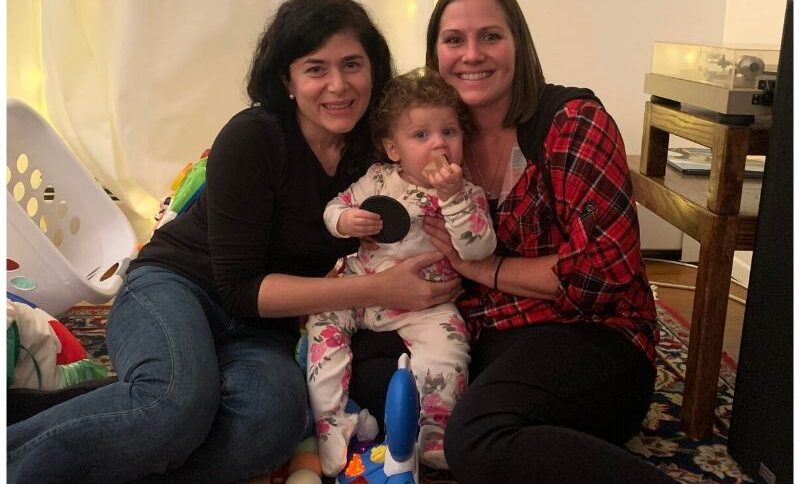
Getting pregnant wasn’t easy; staying pregnant proved almost deadly. I have experienced so much traumatic loss along my journey, but today I am a mother. My husband, family, two very special women, and a grief therapist kept me going. I was able to find my way, and my experience has become a powerful force that allows me to help others.
For me, warning signs came early. At a relatively young age I was diagnosed with PCOS and I knew that trouble conceiving might accompany my diagnosis. My husband and I met later in life and I was in my late 30s before we started trying. It took us more than a year and three IUIs to become pregnant.
The moment our pregnancy test turned positive was the most amazing feeling. We were over the moon! We started taking bets on gender, making a list of names, and fantasizing about how and where we would fit a crib into our small New York City studio apartment. At doctors’ appointments, I treasured every time we heard our baby’s heartbeat. When I saw the 20-week ultrasound photos, I studied them and tried to imagine what our baby was going to look like. When our baby started moving, it was absolutely magical. I tried to pay attention to what foods resulted in more kicks. I wondered—what music did he or she seem to respond to?
Yes, I experienced a lot of the discomforts of pregnancy—swollen feet, difficulty sleeping, back pain, constipation, and more, but I didn’t care. I was so happy that in a few short months our baby was going to arrive into the world.
Then, suddenly, all of the joys of pregnancy came to a screeching halt.
At 31 weeks, my uterus ruptured and our son, Christopher, was stillborn. Despite the outpouring of love and support from our family and friends, we felt isolated and alone in our loss. This wasn’t the type of loss the world is accustomed to dealing with. The doctor told us that the chances of someone (whom had never been pregnant before) experiencing a rupture at 31 weeks was one in a million.
While in the ICU, the ER doctor explained that while I was lucky to be alive, I’d no longer be able to carry a child. We were devastated by this news.
I was distraught, but somehow not hopeless. As the doctor continued to explain what had happened, all I could think about were two women whom were both close to me—my friend Angela, whom I have known since kindergarten, and my cousin, Liz. Both of these women survived cancer and went on to have their children via surrogacy. I kept telling myself that our stillbirth wouldn’t be the end of our path to parenthood.
The next morning, I called both women and begged them to tell me how they did it—the costs, the time frame, the options. What was particularly important to me was learning about gestational surrogacy, which is when an egg from the intended mother is fertilized with the sperm from the intended father (or a donor), then transferred to a surrogate to carry to term. This is different from traditional surrogacy, which is when the surrogate mother is artificially inseminated by the sperm of the intended father (or a donor), then the surrogate carries the baby to term.
These women’s stories were like a light that led me forward, and are a big part of why I’m now dedicating myself to advocating for surrogacy.
If we don’t speak about our struggles and our options, those in need may not even realize surrogacy could be an option, especially here in New York, where it remains illegal. Gestational surrogacy is considered a criminal offense, and moving forward with paid surrogacy in New York would result in a $10,000 fine the first time, and a felony charge if you’re a repeat offender.
Another thing about stillbirth is that there’s no playbook for dealing with such a unique and personal loss when you work in the corporate world. Because stillbirths are so rare, maternity policies often don’t address what happens if you conceive a baby, but don’t ultimately have a baby to care for at home.
The anti-surrogacy statute is an antiquated law that needs to be overturned.
Luckily, there have been leaders and organizations fighting for this cause for nearly a decade, to which I enthusiastically join with my voice and advocacy.
I feel so strongly because I didn’t have the benefit of professional advocate support. In those first critical hours and days that I was dealing with the emotional and psychological trauma of loss, I didn’t know then that there was an entire community out there for people who experience stillbirths. None of the hospital team told us. Luckily, my OB/GYN finally connected us to a grief therapist, who was critical, and told us about books and support groups so we felt less lost and alone.
Another thing about stillbirth is that there’s no playbook for dealing with such a unique and personal loss when you work in the corporate world. Because stillbirths are so rare, maternity policies often don’t address what happens if you conceive a baby, but don’t ultimately have a baby to care for at home.
I went back to work just a few weeks after my loss and C-section. At the time, I went back to work partly because I played a key role at a start-up, but also because I thought it might be better to have the distraction of my work routine. I wish someone could have told me that this was a terrible idea. Immersing myself in a high-pressure work environment while steeped in personal emotional, psychological, and physical distress was not healthy. I wish I had taken more time to grieve, attend to self care, and dedicate those weeks to connect with the community I now know is out there. As stillbirths are (relatively) rare—24,000 a year in the United States—they aren’t often spoken about. But if you’re one of those 1 in 100 pregnancies that end in stillbirth, it changes your life forever.
We ultimately decided to move forward with surrogacy within a few months. I felt supported and well informed by Angela’s and Liz’s experiences, and we knew it could be a long process. I was now at a new job, working for a global media brand with over 4,000 employees, and luckily, the company was based in a state that made it possible for employees to have access to an IVF and a surrogacy benefit. When I went to HR to inquire about the surrogacy benefit, though, they looked at me with astonishment. I was the first employee to ever want to take advantage of the option.
Gestational surrogacy is rare and because it’s not often spoken about, even progressive companies that offer a benefit, haven’t yet figured out what that looks like. It turns out that my plan included an economic stipend, and with proof of our surrogacy contract and a copy of the cancelled payment check, I was able to take advantage of it. What they didn’t have, though, was a policy to support employees on their surrogacy journey. How many weeks of maternity leave does a mother via surrogate get to take? What if I wanted to travel out of state a few weeks early to be there for the birth? Did that count as leave? Luckily, I had a supportive boss who worked through these things with me. As a very senior leader with a lot of experience navigating executive conversations, I was well positioned to advocate for myself. I knew that I was lucky.
This was how I became an advocate for change.
My personal trauma and experience had triggered an unsettling realization—that there were likely many other women (and men) in similar situations who were probably struggling to figure out how to raise and navigate the issue of surrogacy with their employers. I felt compelled to help.
If we don’t speak about our struggles and our options, those in need may not even realize surrogacy could be an option, especially here in New York, where it remains illegal.
My new platform, Fly Bravely, is my attempt to change the world’s perspective on infertility, loss, and surrogacy. I work with individuals and couples experiencing infertility or loss, and those exploring surrogacy or other paths to parenthood to help them move forward despite so many challenges. I also work with corporations to help them understand the experiences I had navigating these issues in the workplace and how they can make it easier for their employees (and become a more attractive employer) by being proactive about these very real needs.
In New York, in particular, there is so much changing. As of January 1, 2020, a new law went into effect so that any company with more than 100 employees must provide infertility benefits to their employees. I’ve often shared this news with friends (even those working in progressive organizations), and they are shocked that this new policy exists.
I’m hopeful that later this year gestational surrogacy will no longer be a crime in New York state. I’m traveling to Albany in February (with Andrea Syrtash, the founder and CEO of pregnantish, among others) to tell my story about my path to parenthood. We’re hoping to convince State Assembly Members to support the governor in making gestational surrogacy legal in New York.
Today, I am blessed and amazed to be “mama” to my 18-month old daughter, Carolina. She is the light of my life and will grow up knowing we wanted her so badly. Our surrogacy journey was long, difficult, and expensive. Because of the ban in New York, we hired an agency in Boston, Massachusetts, created our embryos (and did our transfer) in Connecticut, and our daughter was gestated by our incredible gestational surrogate, Marissa, in Utah.
Since Carolina’s arrival, we exchange weekly texts with Marissa, keeping her up to date on Carolina’s latest milestones and sharing pictures of her. We’ve been so grateful that she has come to visit us in New York twice in the past year. Carolina will grow up knowing that she is deeply loved! She will understand that she is here because her parents didn’t give up and because of the brave, strong surrogate who will forever be a part of her life and a part of her story.
Contributor
Lia Buffa De Feo
Lia Buffa De Feo is a mother through surrogacy, the founder of Fly Bravely, and an advocate for legalizing surrogacy, destigmatizing infertility and loss, and making it all more bearable in the workplace.

Listen to stories, share your own, and get feedback from the community.


















